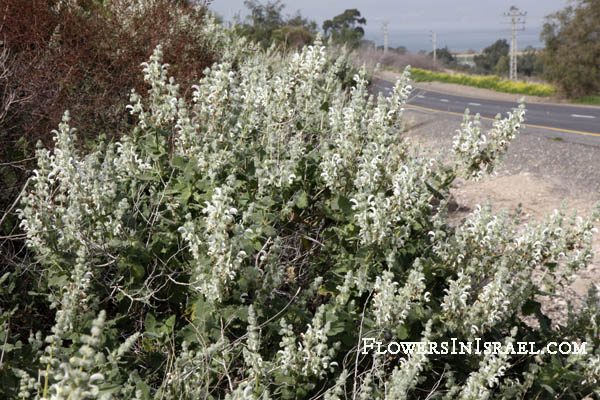Hebrew: מרווה ריחנית, Arabic: Khowwekha, خويخة
| Scientific name: | Salvia dominica L. | |
| Synonym name: | Salvia graveolens Vahl | |
| Common name: | Dominican Sage | |
| Hebrew name: | מרווה ריחנית | |
| Arabic name: | Khowwekha, خويخة | |
| Family: | Labiatae / Lamiaceae, שפתניים |

|
| Life form: | Chamaephyte, semi-shrub | |
| Stems: | Up to 100 cm high; stem, towards the root, suffruticose, erect, pubescent; branches and stem square | |
| Leaves: | Opposite, entire, dentate or serrate | |
| Flowers: | White flowers terminating, in whorls, peduncled | |
| Fruits / pods: | Nutlets 4, glabrous ellipsoid to ± spherical | |
| Flowering Period: | February, March, April, May | |
| Habitat: | Batha, Phrygana | |
| Distribution: | The Mediterranean Woodlands and Shrublands, Semi-steppe shrublands, Shrub-steppes, Deserts and extreme deserts | |
| Chorotype: | Mediterranean | |
| Summer shedding: | Perennating |

Derivation of the botanical name: Salvia, Latin salvere, to save, referring to the long-believed healing properties of salvia. Pliny the Elder was the first known to use the Latin name salvia. dominica, island of Dominica, which means "belonging to the Lord." graveolens, strong smelling; referring to the fragrant glands on the hairs covering the leaf, making it a more relevant epithet than dominica. The Israeli botanists Dr. Ephraim and Hanah Hareuveni pointed out that the architecture of the vertical inflorescence of this species of Salvia resembles the shape of the Menorah, in particular—the Salvia Palaestina. Therefore, they suggested that it had inspired the design of the Menorah. Moreover, based on etymology perspectives they suggested that the Hebrew word “Marva, מרווה” (Salvia) was originated from the Hebrew word “Moriah” (the Temple Mount name), reflecting the connection between this plant and the Menorah, which was situated inside the Holy Temple in Jerusalem.
Bible Resources:
|


